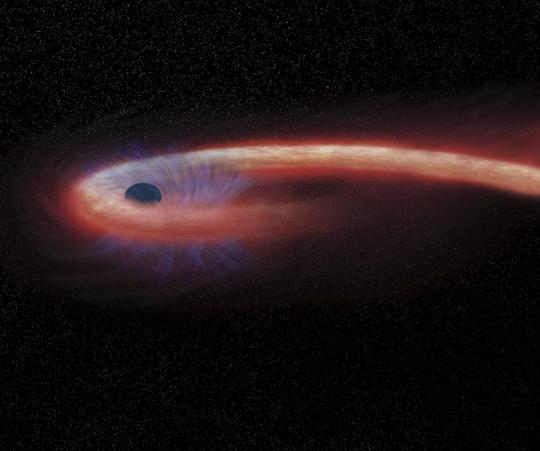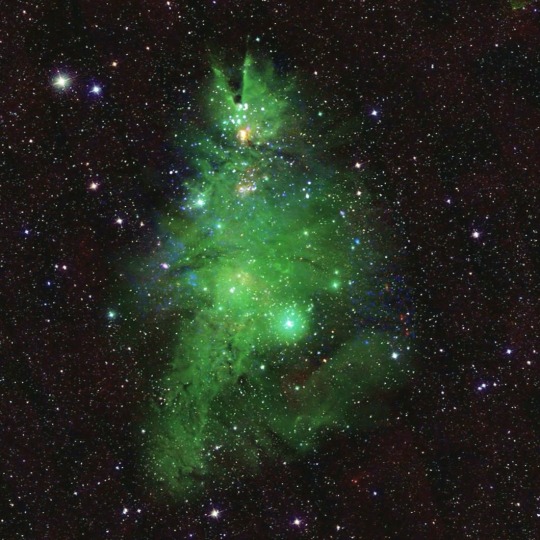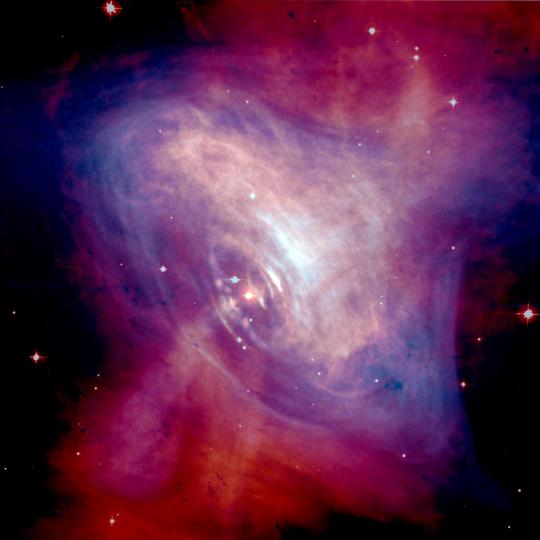#chandra x-ray observatory
Explore tagged Tumblr posts
Video
O Christmas Tree! by NASA's Marshall Space Flight Center Via Flickr: A new version of the “Christmas tree cluster” is now available. Like NGC 602, NGC 2264 is a cluster of young stars between one and five million years old. (For comparison, the Sun is a middle-aged star about 5 billion years old — about 1,000 times older.) In this image of NGC 2264, which is much closer than NGC 602 at a distance of about 2,500 light-years from Earth, data from NASA's Chandra X-ray Observatory (red, purple, blue, and white) has been combined with optical data (green and violet) captured from by astrophotographer Michael Clow from his telescope in Arizona in November 2024. Credit: X-ray: NASA/CXC/SAO; Optical: Clow, M.; Image Processing: NASA/CXC/SAO/L. Frattare and K. Arcand #NASAMarshall #NASA #astrophysics #NASAChandra #NASA #JWST #NASAWebb #star #starcluster Read more Read more about the Chandra X-ray Observatory NASA Media Usage Guidelines
#NASA#NASA's Marshall Space Flight Center#NASA Marshall#Marshall#MSFC#Solar System & Beyond#astronomy#astrophysics#Chandra X-Ray Observatory#star#star cluster#flickr
96 notes
·
View notes
Text

Black holes use gravity to pull matter into them.
NASA/Chandra X-ray Observatory/M.Weiss via AP
104 notes
·
View notes
Text

The Star Cluster NGC 602
A image of star cluster NGC 602 from Chandra & NASAWebb is about 175 light-years across and it sparkles with the light from thousands of stars.
The star cluster NGC 602 lies on the outskirts of the Small Magellanic Cloud, which is one of the closest galaxies to the Milky Way, about 200,000 light-years from Earth. The stars in NGC 602 have fewer heavier elements compared to the Sun and most of the rest of the galaxy. Instead, the conditions within NGC 602 mimic those for stars found billions of years ago when the universe was much younger.
This new image combines data from NASA’s Chandra X-ray Observatory with a previously released image from the agency’s James Webb Space Telescope. The dark ring-like outline of the wreath seen in Webb data (represented as orange, yellow, green, and blue) is made up of dense clouds of filled dust.
Credit X-ray: NASA/CXC; Infrared: ESA/Webb, NASA & CSA, P. Zeilder, E.Sabbi, A. Nota, M. Zamani;
Image Processing: NASA/CXC/SAO/L. Frattare and K. Arcand.
Release Date December 17, 2024.
#The Star Cluster NGC 602#James Webb Space Telescope#Chandra X-ray Observatory#nasa#nasa photos#nasa picture of the day#spacee#space exploration#outer space
27 notes
·
View notes
Text
Scientists have discovered the oldest black hole yet, a cosmic beast formed a mere 470 million years after the Big Bang. The findings, published Monday, confirm what until now were theories that supermassive black holes existed at the dawn of the universe. NASA's James Webb Space Telescope and Chandra X-Ray Observatory teamed up over the past year to make the observations. Given the universe is 13.7 billion years old, that puts the age of this black hole at 13.2 billion years. Even more astounding to scientists, this black hole is a whopper—10 times bigger than the black hole in our own Milky Way.
Continue Reading.
174 notes
·
View notes
Text

"This new image of NGC 2264, also known as the 'Christmas Tree Cluster,' shows the shape of a cosmic tree with the glow of stellar lights. NGC 2264 is, in fact, a cluster of young stars — with ages between about one and five million years old — in our Milky Way about 2,500 light-years away from Earth. The stars in NGC 2264 are both smaller and larger than the Sun, ranging from some with less than a tenth the mass of the Sun to others containing about seven solar masses.
This new composite image enhances the resemblance to a Christmas tree through choices of color and rotation. The blue and white lights (which blink in the animated version of this image) are young stars that give off X-rays detected by NASA’s Chandra X-ray Observatory. Optical data from the National Science Foundation’s WIYN 0.9-meter telescope on Kitt Peak shows gas in the nebula in green, corresponding to the 'pine needles' of the tree, and infrared data from the Two Micron All Sky Survey shows foreground and background stars in white. This image has been rotated clockwise by about 160 degrees from the astronomer’s standard of North pointing upward, so that it appears like the top of the tree is toward the top of the image.

Young stars, like those in NGC 2264, are volatile and undergo strong flares in X-rays and other types of variations seen in different types of light. The coordinated, blinking variations shown in this animation, however, are artificial, to emphasize the locations of the stars seen in X-rays and highlight the similarity of this object to a Christmas tree. In reality the variations of the stars are not synchronized.
The variations observed by Chandra and other telescopes are caused by several different processes. Some of these are related to activity involving magnetic fields, including flares like those undergone by the Sun — but much more powerful — and hot spots and dark regions on the surfaces of the stars that go in and out of view as the stars rotate. There can also be changes in the thickness of gas obscuring the stars, and changes in the amount of material still falling onto the stars from disks of surrounding gas.
NASA’s Marshall Space Flight Center manages the Chandra program. The Smithsonian Astrophysical Observatory’s Chandra X-ray Center controls science operations from Cambridge, Massachusetts, and flight operations from Burlington, Massachusetts."
Date: December 19, 2023
NASA ID: link
#NGC 2264#Christmas Tree Cluster#Space#Galaxy#NASA#December#2023#gif#Chandra X-ray Observatory#X-ray Observatory#Chandra#Marshall Space Flight Center#MSFC#Huntsville#Alabama#my post
87 notes
·
View notes
Text



24 December 2023
💚🎄💚
#NASA#Christmas Tree Cluster#Christmas Tree#stars#space#galaxy#universe#cosmos#Christmas#Christmas Eve#Chandra X-ray Observatory#space telescope#space observatory#X-ray astronomy
36 notes
·
View notes
Text
The Christmas Tree Cluster

About 2,500 light-years from Earth, this community of young stars (less than 5 million years old - our middle-aged Sun has been burning for more than 5 billion years) give off X-rays that help light up the green nebula surrounding them, giving this cluster (NGC 2264) its nickname.
18 notes
·
View notes
Text

Púlsar de la Nebulosa del Cangrejo. Imágenes combinadas procedentes del Telescopio Espacial Hubble (en rojo) y del Observatorio de Rayos X Chandra (en azul).
#astronomy#space#pulsar#neutron star#crab nebula#supernova#crab pulsar#hubble#chandra#hubble space telescope#chandra x-ray observatory#astronomía#espacio#nebulosa del cangrejo#púlsar#telescopio espacial hubble#observatorio de rayos-x chandra#estrella de neutrones
11 notes
·
View notes
Text

Launch of Space Shuttle Columbia during STS-93. July 23, 1999.
STS-93's primary mission was the deployment of the Chandra X-Ray Observatory. At the time of its launch, Chandra was the most sophisticated X-ray telescope ever built.

Chandra and the Inertial Upper Stage, after deployment.
In addition to the deployment of Chandra, STS-93 carried numerous experiments into low Earth orbit, including studying the effects of micro-gravity on muscle and bone tissue, the feasibility of short-wave radio contact between the space shuttle and ground-based amateur radio operators, and plant growth investigations.
With STS-93, astronaut Eileen Collins became the first woman to command a Space Shuttle mission. Collins was also the first woman to pilot the Space Shuttle.

STS-93 crew on orbit. Back row, from left: Mission Specialist Steven Hawley, Pilot Jeffrey Ashby, Mission Specialist Cady Coleman. Front row, from left: Commander Eileen Collins, Mission Specialist Michel Tognini of France's Centre National d'Etudes Spatiale.
NASA
#Space Shuttle Program#Space Shuttle Columbia#STS-93#Chandra X-Ray Observatory#NASA#CNES#spaceflight
3 notes
·
View notes
Text
Record-Smashing Black Hole Born in Universe’s Infancy - Technology Org
New Post has been published on https://thedigitalinsider.com/record-smashing-black-hole-born-in-universes-infancy-technology-org/
Record-Smashing Black Hole Born in Universe’s Infancy - Technology Org
An international team of astrophysicists, including Princeton’s Andy Goulding has discovered the most distant supermassive black hole ever found, using two NASA space telescopes: the Chandra X-ray Observatory (Chandra) and the James Webb Space Telescope (JWST).
Astrophysicists combined data from JWST and the Chandra X-ray Observatory to identify the growing black hole at the center of this image. Image credit: X-ray: NASA/CXC/SAO/Ákos Bogdán et al.; Infrared: NASA/ESA/CSA/STScI; Image processing: NASA/CXC/SAO/L. Frattare, K. Arcand
The black hole, which is an estimated 10 to 100 million times more massive than our sun, is 13.2 billion light-years away in the galaxy UHZ-1, which means the telescopes are peering back in time to when the universe was “extremely young,” Goulding said — only about 450 million years old.
“This is one of the most dramatic discoveries to come out of the James Webb Space Telescope” and the discovery of the most distant growing supermassive black hole known, said Michael Strauss, professor and chair of astrophysical sciences at Princeton, who discussed the findings with the researchers but was not part of the research team. “Indeed, it completely smashes the old record.”
Precisely how the first black holes were formed in the universe’s infancy has been a long-standing debate among astronomers.
“Now, finally discovering a black hole that was so large, when the universe was so young, tells us that the black hole must have been very large when it was initially formed, probably from the direct collapse of a massive gas cloud,” said Goulding, who is a research scientist in Princeton’s Department of Astrophysical Sciences.
It also means that astronomers can rule out other formation models, like the death of the first massive stars, because those couldn’t produce a black hole large enough to explain UHZ-1, he added.
“The black hole has only a very short time to grow,” he said. “It either grew extraordinarily fast or the black hole was simply born larger.”
Goulding is one of the lead authors of the primary paper announcing the result and the lead author of a separate paper in The Astrophysical Journal Letters detailing the mass of the galaxy and its extraordinary distance, which was pivotal to the overall result.
Different telescopes have different tools to peer into the universe, and combining data from multiple instruments can yield more than a sum of their parts. “We needed Webb to find this remarkably distant galaxy and Chandra to find its supermassive black hole,” said Ákos Bogdán of the Center for Astrophysics-Harvard & Smithsonian in the press release. Bogdan is first author on the Nature Astronomy paper.
Written by Liz Fuller-Wright
Source: Princeton University
You can offer your link to a page which is relevant to the topic of this post.
#amp#Astronomy#Astronomy news#Astrophysics#billion#black hole#Black holes#Born#Chandra X-ray Observatory#Cloud#data#Discoveries#ESA#Featured Space news#Fundamental physics news#Galaxy#gas#how#indeed#international team#it#James Webb Space Telescope#jwst#Light#Link#mass#NASA#nature#One#Other
2 notes
·
View notes
Text
The Sun creates enormous sound waves through its constant churning of plasma and fusion reactions. These waves are essentially pressure oscillations that travel through the Sun's plasma. Scientists call these oscillations "solar oscillations" or "helioseismic waves."
The "sound" these oscillations would make, if we could hear them, would be far below the range of human hearing - around 3 mHz (millihertz), or about 0.003 Hz. For comparison, humans generally hear between 20 Hz and 20,000 Hz.
The reason we can't hear these sounds on Earth is simple: sound waves need a medium to travel through (like air or water), and space is essentially a vacuum. There's no medium for the sound to travel from the Sun to Earth.
However, scientists have found ways to "listen" to the Sun:
NASA and other space agencies have converted the Sun's vibrations and electromagnetic variations into audible frequencies. This process is called "sonification" - it's not actual sound, but rather data converted into sound we can hear.
These solar "sounds" often come out as eerie humming or pulsing noises. The Sun essentially "rings" like a bell, but at frequencies millions of times deeper than we can hear.
The study of these solar oscillations (helioseismology) is actually quite important - it helps scientists understand the Sun's internal structure and dynamics, much like how seismology helps us understand Earth's interior.
I watched a video on sonification with astrophysicist and data sonification expert Kimberly Arcand the other day via StarTalk. It's over an hour long but worth the watch! They also mention Wanda Díaz-Merced, a blind astronomer who pioneered the use of sonification to study visual data! https://www.youtube.com/watch?v=sSl3bHuls80

#very cool#sun#solar#vacuum of space#nasa#sonification#jwst#Chandra X-Ray Observatory#data#no but you don't understand how much i love women in science#and when others use their platform to share their knowledge with us
7K notes
·
View notes
Photo

SN1006 !
On this day in the year 1006, a "new star" appeared in the sky. SN1006 was so bright it could be seen during the the day for several weeks, and was documented by observers from Europe and Africa to the Far East, and was possibly recorded in North American petroglyphs;
SN1006 was a supernova 7,200 light-years from Earth, and is thought to have shined 16 times the brightness of Venus. The image above is the remnant of this event, thought to be a supernova of Type 1a caused by two white dwarves combining.
This remarkable image was created from pictures taken by different telescopes in space and on the ground. It shows the thousand-year-old remnant of the brilliant SN 1006 supernova, as seen in radio (red), X-ray (blue) and visible light (yellow).
Credit:
Radio: NRAO/AUI/NSF/GBT/VLA/Dyer, Maddalena & Cornwell, X-ray: Chandra X-ray Observatory; NASA/CXC/Rutgers/G. Cassam-Chenaï, J. Hughes et al., Visible light: 0.9-metre Curtis Schmidt optical telescope; NOAO/AURA/NSF/CTIO/Middlebury College/F. Winkler and Digitized Sky Survey.
#art#photography#space#cosmos#cosmic#universe#suernova#SN1006#star wars#petroglyphs#chandra x-ray observatory
64 notes
·
View notes
Text
The triumph of ignorance. How does dark-age thinking threaten our existence?
“Dark-age thinking” lacks imagination. It is anti-science, anti-art, and anti-exploration. It assures a lack of human progress because it can’t imagine what human progress looks like. A hundred years ago, it would not have imagined the Internet, smart watches, smart phones, jet planes, GPS, supercomputers, 3-D printing, robotic surgery, antibiotics, genome editing, CRISPR, transistors, solar…

View On WordPress
#Alpha Magnetic Spectrometer#Chandra X-ray Observatory#dark-age thinking#Jet Propulsion Laboratory#monetary sovereignty
0 notes
Link
X-ray: (Chandra) NASA/CXC/U. Manitoba/C. Treyturik, (XMM-Newton) ESA/C. Treyturik; Optical: (Pan-STA...
0 notes
Photo
[source]

The Galactic Center in Stars, Gas, and Magnetism
Credits: NASA, CXC, UMass, Q.D. Wang, NRF, SARAO, MeerKAT
#reblog#apod#astronomy#galactic centre#milky way#sagittarius#chandra x-ray observatory#multiwavelength
324 notes
·
View notes
Text

'New images that combine data from NASA’s Chandra X-ray Observatory and James Webb Space Telescope' Release Date: 23 May '23. 'Chandra observes X-rays from cosmic objects, while Webb is sensitive to infrared light.'
1 note
·
View note
